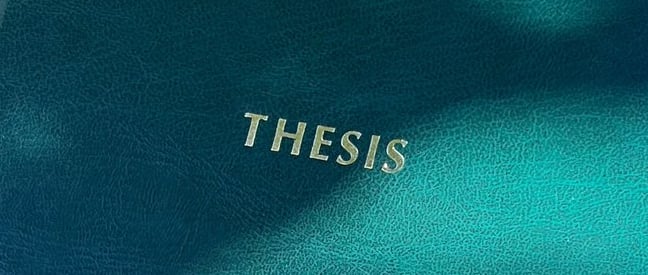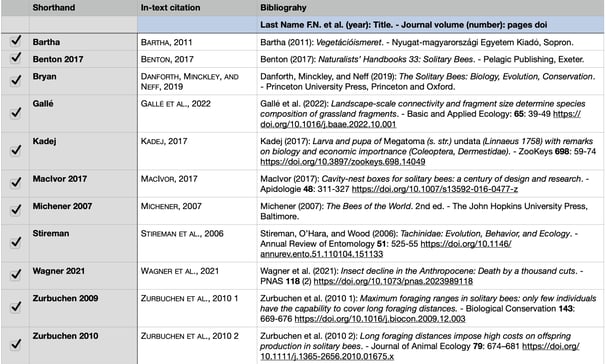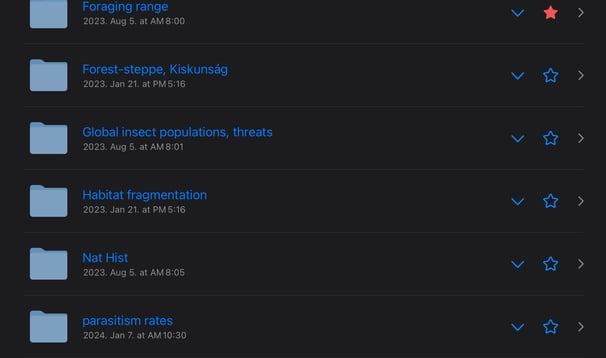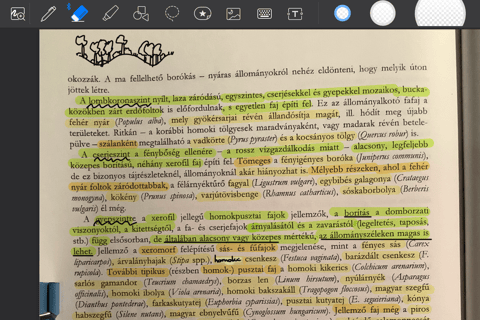Tips for Writing a Thesis
Writing a thesis can be a daunting task! For many, this is their first large-scale project. In this post, I share what helped make the process easier.


You have the topic. You have the advisor. Now, you “just” need to write 10-20 000 words about it… And then defend it. No pressure!
In many ways, my approach to writing my thesis was the same as writing any essay (I’m using many of the tips as I write this very blogpost!). But with a thesis, it is even more crucial to be organized and keep a standardized approach to everything, since you are working on it for such an extended period of time. Below, I expand on what that looked like for me. It’s all about making the job easier for future you!
This post is by no means a comprehensive guide to writing a thesis. I also don't expand on other aspects of a thesis project, like data management and organization. In this post, I'm mainly focusing on the writing part!
As you work on your project
Have a notebook dedicated to your thesis project
This is where you record:notes from meetings with your advisor,
ideas and notes of your own,
to do lists on things you need to work on,
sketches of ideas for graphs, page layouts, etc.
Having one place for all these notes is useful as you work on such a complex project.
Write down EVERYTHING
As you work on your project, make notes as necessary. I promise you, you will not remember that thing. No matter how obvious it might seem in the moment, you will thank yourself later when you are trying to create an overarching storyline of your project.
One thing I did, was collect additional data, not requested by my advisors. It didn’t add much time, but ended up coming in handy in the final analysis of the methodologies I was comparing. Think about what is interesting to you regarding your project, not necessarily addressed by your mentors. You never know, it might end up being a valuable piece of the story!
Where do I even start when writing a thesis?
Create a skeleton of the thesis
This is my no. 1 tip when it comes to writing long-form essays. Creating the main structure of the thesis will break the task down into more digestable pieces. You will need to know what requirements your university has for length of various chapters and formatting.
Start with the cover page.
Add the main headings and subheadings, separate them with page breaks where necessary. If you know you need to write 2 pages for a given section, separate that heading and the next with two page breaks.
BAM! You have a 14 page document! Now slowly start filling everything in.
This works on a small scale, too; within chapters. Let’s say you need to write about 12 different species. Write each one out, leaving two rows between each one, then start writing. This way, you can start writing about multiple, and out of order. You can always go back and add more details as you go.
Create and follow standards
Again, refer to your school’s guides to standards. What chapters are necessary? What does the cover page look like? What about footnotes and citations? What should the font, size, alignment, etc. be? If there is no consensus for formatting, create your own. This will create a cohesive and polished look to your document.
Always format photos the same (eg. centered, text wrap above and below) and add captions the same (eg. 10pt Times New Roman, aligned to center). Get good at making bibliographies — standardizing format of citations.
Paragraph styles are your friend. Use them!
Fill your brain with ideas until they spill out onto the page
I usually read a lot of articles or books for a given section. Then, when I feel like I’m bursting with things to write about, I start writing. It’s helpful to just write, and only go back and edit, checking grammar and word choice, later (I got this tip from Julia Ravey, who has several great videos on writing a thesis).
As you write, there will be things you want to come back to. I always marked these with “XX”. It removes the speedbump — instead of having to go on a tangent to figure out what I need to write, I move on to what I do know. Essay-writing is non-linear.
Eg. “Megachile are XX mm in length”. Not only is does it visibly stand out, but it’s easy to search for later when you want to fill in those gaps. This is what helps you keep focused and get as much writing done in what sitting, rather than constantly being distracted by going down rabbit holes to fill those knowledge gaps.
For reading, I’ve found it most useful to write straight from the document instead of taking my own notes and then writing from that. This way, you can guarantee that you aren’t plagiarizing the original text.
I tried multiple methods of reading papers — on my computer, printing it out.. Highlighting things on the computer is cumbersome and I felt very blocked in my workflow. The issue I had with printed material was, I didn't want to print out papers that wouldn't end up being important. Also, it's not searchable. Then I got an iPad and it was such a game changer. The amount of papers I printed after getting my iPad drastically declined.
I use GoodNotes 5 (paid app, available on iOS, Android, Windows, Chromebook) on my iPad. It can even highlight on photos or scanned texts.
Find good sources to use
A good place to start is Google Scholar, and other search engines and repositories. You can also search up books on the subject which will provide the bulk of the introductory material necessary.
I sourced all my papers by either finding an open source version, or emailing the author for a copy of the paper. Authors aren’t paid by publishers, so they are typically more than happy to send you their paper!
Google Chrome extensions I used for finding open-access versions of literature were UnPaywall and SciHub (or use SciHub through the website)
When reading articles, start with the Abstract, then, if you find it relevant to your project, read the Introduction and the Discussion section. You can then read other parts like Methods if necessary. I oftentimes read through the bibliography as well, to find similar articles I might want to use.
You can also use tools like Connected Papers, Research Rabbit, and LitMaps to find other relevant articles to read.
As you work on writing
Keep track of sources
ALWAYS ALWAYS make the bibliography as you go. It is incredibly hard to track everything down after the fact. When you write, put the basic citation in parenthesis — eg. "(Herrmann et al., 2025)" — after each sentence or paragraph, if you took all the information from one paper. Create shorthands if you want to stay in the writing workflow. You can format it properly later, but make it obvious which paper it’s from.
Similarly, keep track of where you downloaded photos from, so you can properly cite them. I usually copy-paste the link into the file info (this function is available for both iOS and Windows). Again, it is so hard to track down images after-the-fact (reverse image searching does help a bit, but it can't be relied on!).
Organize your files
I recommend downloading all papers you read and reference in your thesis. Keep your literature organized by topic. I had folders for studies detailing the method or species I was studying, or more specific topics like studies on foraging range. I did the same for photos.
Create a workflow and a schedule
Workflow-wise, I usually work on the part I am most excited about and work from there. When I get bored working on one chapter, I will move on to another. If I’m not in the mood to write, I gather literature, add photos, or work on formatting.
Writing a big essay or a thesis requires many small tasks. Reading, writing, editing, statistical analysis, photo sourcing, formatting, etc. Depending on my current motivations and energy level, I chose different parts to work on. If I was feeling creative, I would write. If I didn’t feel like I had enough material to work off of, I would read. If I wanted to add to the project, but wasn’t feeling motivated to read or write, I would choose tasks requiring lower levels of commitment, such as looking for good photos to use, organizing my files, making tables, or formatting (eg. finding the right colors for my diagrams).
Generally, I tried to work on my thesis every day, or at least 4-6 days a week. Concentration levels change throughout the day. I would work for a few hours, until I found myself getting distracted, and then I would eat or take a little break. Soon enough, I was feeling ready to get back into things.
Even if your deadline is far out, try to work on your project and put in consistent hours. And if the deadline is fast approaching, you will have no choice but to keep pushing the gas pedal! Don't stress — you got this!
Don’t delete anything permanently
Have a document where you can keep deleted segments. This way, if you end up needing some of it, you have it, and it’s not lost to the abyss. This came in handy multiple times.
That’s all I have! Hopefully I could make the task of writing a thesis less daunting. Good luck!


Creating shorthands for a streamlined workflow: Refer to papers in a way that makes sense to you, but is also unique to the paper. As you can see, most of my shorthands were pretty straightforward, but there were some like "Bryan" :D
You can also see the format I followed for citations. Again, this will depend on your school requirements. Just make it the same throughout!




Standardize file names of literature
The format I followed was: LAST AUTHOR_first author_year_title (following a tip from Twitter — I will link to the tweet when I find it). Putting the last author first guarantees that all papers from the same lab will be grouped together.
This is a screenshot of my GoodNotes folders on my iPad. This made it easy to focus in on a certain topic and only read articles relevant to the chapter I was currently working on.


In the GoodNotes app, you can easily annotate and highlight scanned books as well. I found this function super useful!